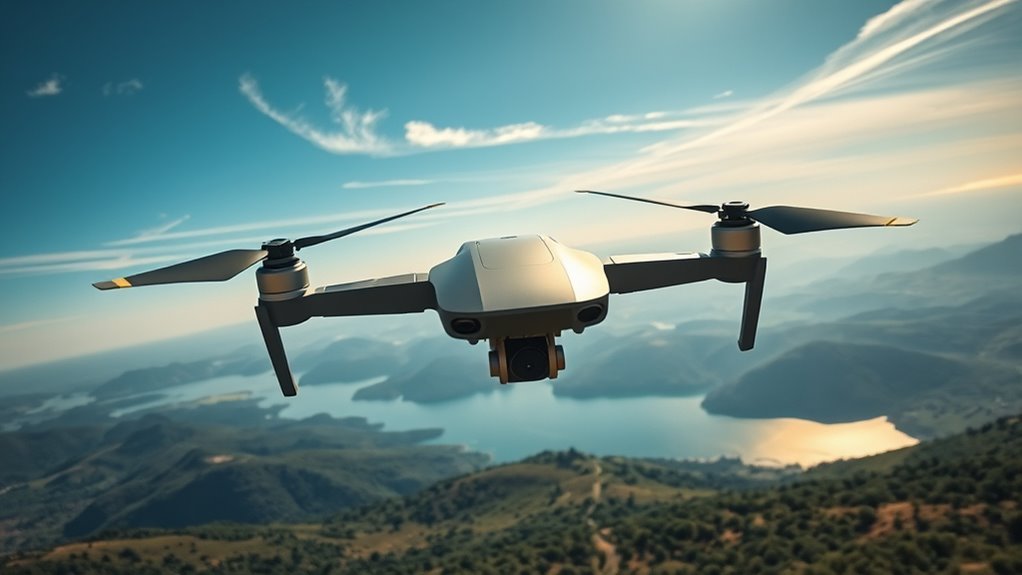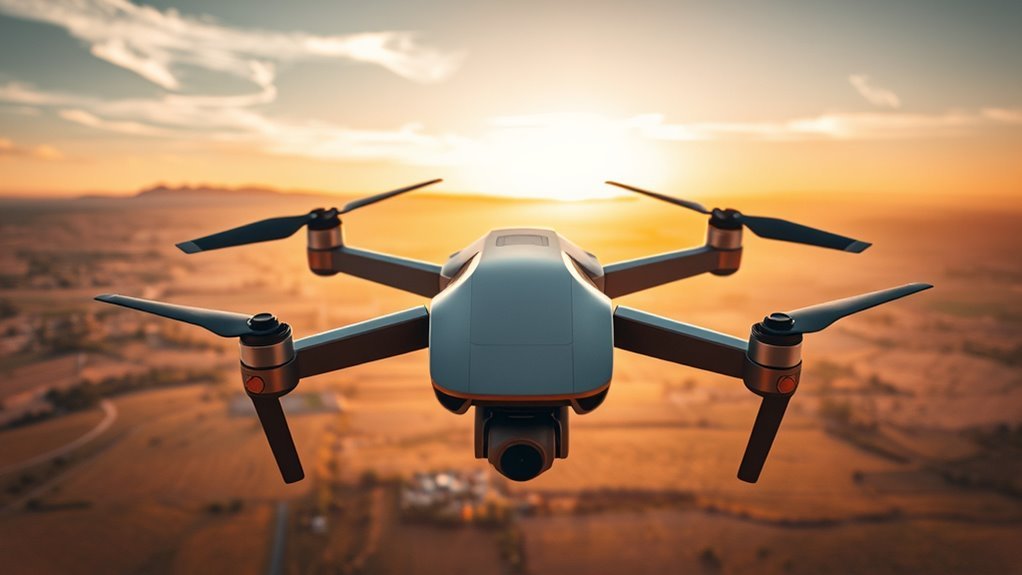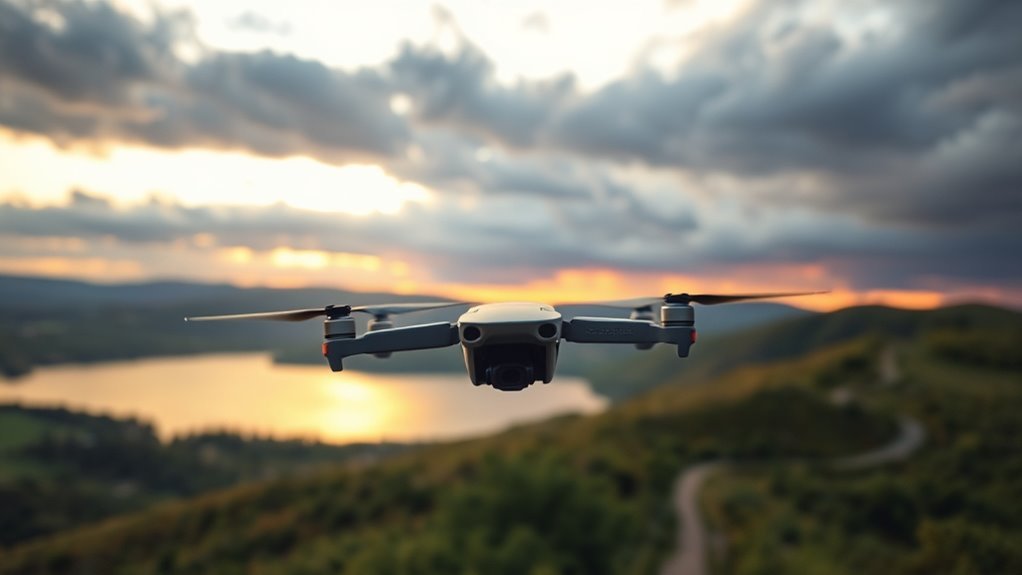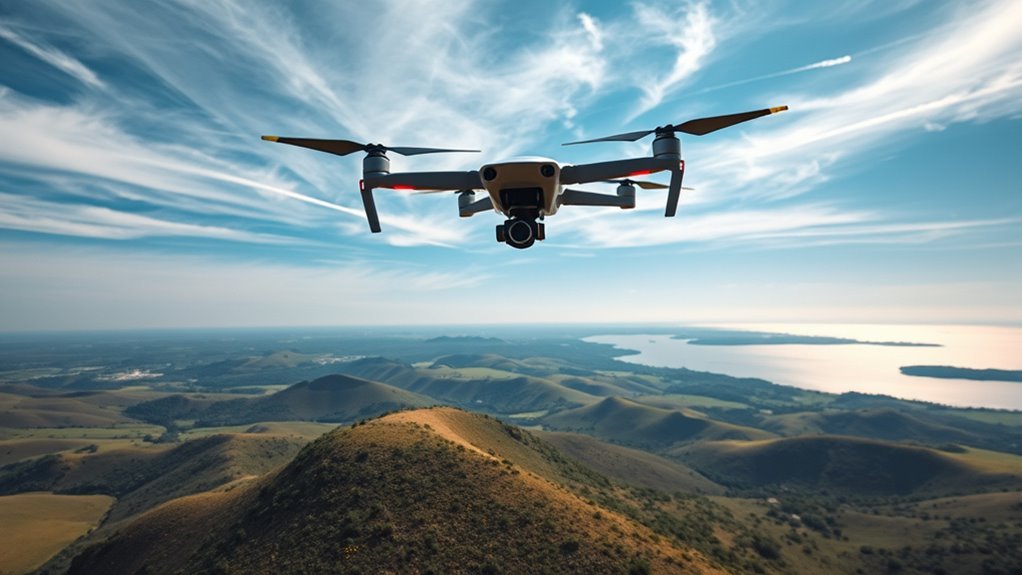You can expect most consumer drones to fly between 1 and 7 miles, depending heavily on design, battery capacity, and environmental factors like wind. Professional drones often exceed 10 miles, thanks to advanced systems and optimized efficiency. Signal strength and communication protocols also limit range, while payload and weight distribution affect energy use. Understanding these variables offers clearer insights into extending your drone’s flight capabilities and how to optimize for longer, stable missions.
Factors Affecting Drone Flight Distance

Although drone flight distance is often advertised as a fixed number, several critical factors influence the actual range you can achieve. One primary consideration is drone design; aerodynamic efficiency reduces drag, allowing your drone to glide farther on the same power. Streamlined frames and optimized propeller shapes contribute greatly. Weight distribution also plays a pivotal role—imbalanced loads increase energy consumption, diminishing flight distance. By ensuring components and payloads are evenly distributed, you maintain stability and maximize efficiency. Additionally, structural materials affect overall weight and durability, impacting how far your drone can travel before power constraints intervene. Understanding these technical elements empowers you to select or modify drones that suit your desire for extended freedom in flight, ensuring you push distance limits without sacrificing control or performance.
Battery Life and Its Impact on Range

Since battery life directly dictates how long your drone can stay airborne, it fundamentally limits its maximum flight range. The core determinant here is battery capacity, measured in milliampere-hours (mAh) or watt-hours (Wh), which quantifies the total energy your drone can store. However, capacity alone doesn’t guarantee distance; energy efficiency plays an equally important role. More efficient motors and enhanced flight algorithms reduce power consumption, extending flight time. You’ll find that drones with higher battery capacity and superior energy efficiency offer greater freedom to explore, pushing your operational boundaries. Yet, increasing capacity usually adds weight, which can counteract efficiency gains. Balancing these factors is key: maximizing battery capacity while enhancing energy efficiency enables your drone to achieve ideal range, granting you the liberty to venture further without compromise.
Signal Strength and Communication Limits

You’ll need to contemplate how signal range is influenced by factors like frequency, power output, and antenna design. Different communication technologies, such as radio frequency or cellular networks, offer varying levels of reliability and distance. Additionally, interference from other signals and physical obstacles can greatly reduce effective communication limits.
Signal Range Factors
When you operate a drone, the signal range is primarily influenced by the strength of the transmission and the communication protocols in use. The signal strength dictates how far your drone can maintain a stable connection without degradation. Communication protocols, designed to optimize data exchange, directly affect latency and error correction, essential for maintaining control at extended distances. However, signal interference from obstacles or other electronic devices can drastically reduce effective range, causing data loss or connection drops. Understanding these factors allows you to anticipate limitations and adjust your flight boundaries accordingly. For maximum freedom, you need to balance transmission power with protocol efficiency while minimizing interference, ensuring your drone stays responsive and within control throughout its flight envelope.
Communication Technology Types
Although signal strength plays a crucial role in drone communication, the type of technology used determines both the effective range and reliability of the connection. You’ll find that communication protocols like Wi-Fi, radio frequency (RF), and LTE each use distinct transmission methods influencing your drone’s operational freedom. Wi-Fi offers limited range but high data rates, while RF protocols, often operating in 2.4 GHz or 5.8 GHz bands, provide longer reach with lower latency. LTE networks enable extensive range by leveraging cellular infrastructure but depend on coverage availability. Your choice of protocol impacts not only signal penetration but also resistance to latency and dropouts. Understanding these communication technology types lets you optimize control distance and data integrity, ensuring your drone flies as far and freely as the technology allows.
Interference and Obstacles
Selecting the right communication technology sets the foundation for your drone’s range, but the environment ultimately dictates how far your signal can travel. Interference sources like Wi-Fi networks, radio towers, and even other drones can degrade signal strength, limiting your control radius. Obstacle navigation is critical; physical barriers such as buildings, trees, and terrain can block or reflect signals, causing communication drops. To optimize range, consider:
- Identifying and minimizing nearby interference sources.
- Choosing frequencies less congested in your operating area.
- Utilizing advanced antenna designs for better signal penetration.
- Planning flight paths that avoid dense obstacle clusters.
Differences Between Consumer and Professional Drones
When comparing consumer and professional drones, you’ll notice significant differences in flight range, largely influenced by battery capacity and efficiency. Professional models often support longer battery life and higher payloads, which directly affect their operational distance. Understanding these factors is key to evaluating how far each drone type can effectively fly.
Flight Range Comparison
While consumer drones typically offer flight ranges between 1 to 7 miles, professional drones can extend well beyond 10 miles due to advanced communication systems, higher-capacity batteries, and optimized aerodynamics. When you evaluate flight range via rigorous range testing, these factors become clear. Here’s what differentiates them:
- Communication Protocols: Professional drones use long-range radio frequencies and mesh networks for extended control.
- Battery Efficiency: Enhanced energy density allows longer sustained flights.
- Aerodynamic Design: Streamlined frames reduce drag, improving range.
- Redundant Systems: Fail-safes prevent signal loss, maintaining operational freedom.
Understanding these elements in drone technology guarantees you select a model that truly matches your desire for expansive flight freedom and mission-critical reliability.
Battery Life Variances
Two key factors define the battery life variances between consumer and professional drones: battery capacity and power management systems. Consumer drones typically use smaller batteries with moderate energy density, prioritizing lightweight design over prolonged flight. Their battery technology focuses on cost efficiency and ease of replacement, limiting maximum flight time. In contrast, professional drones integrate advanced battery technology, such as high-capacity lithium polymer cells, optimized for extended endurance. These drones employ sophisticated power management systems that regulate energy consumption meticulously, enhancing overall energy efficiency. This allows you greater operational freedom, enabling longer missions without frequent recharges. Understanding these differences helps you select a drone that aligns with your flight range needs, ensuring you’re not constrained by battery limitations when exploring or working remotely.
Payload Impact Differences
Battery capacity and power management set the foundation for flight duration, but payload also plays a significant role in how far a drone can travel. When comparing consumer and professional drones, payload capacity and weight distribution drastically affect performance. Here’s what you need to evaluate:
- Payload Capacity: Professional drones often support heavier payloads, enabling advanced sensors or cameras but consuming more energy.
- Weight Distribution: Precision in balancing payload improves aerodynamic efficiency, extending range.
- Consumer Drones: Limited payload capacity restricts additional equipment, improving flight distance but limiting functionality.
- Professional Drones: Designed to optimize weight distribution for heavier payloads, but this reduces maximum flight distance due to energy demands.
Understanding these differences helps you choose the right drone that balances your desired freedom with operational range.
Environmental Conditions Influencing Flight Range
Because environmental factors directly impact a drone’s performance, you need to account for variables such as wind speed, temperature, humidity, and altitude when estimating flight range. Weather patterns critically influence energy consumption; for example, strong headwinds increase drag, reducing battery efficiency and cutting your drone’s maximum distance. Conversely, tailwinds can extend flight range but are less predictable. Altitude effects also play a significant role—thinner air at higher elevations decreases lift, forcing motors to work harder and drain power faster. Temperature shifts impact battery chemistry, where cold conditions reduce capacity and shorten flight duration. Humidity can affect air density and sensor accuracy, subtly influencing control and stability. Understanding these environmental parameters guarantees you can realistically gauge your drone’s operational freedom in diverse conditions.
Tips to Maximize Your Drone’s Flying Distance
Maximizing your drone’s flying distance requires strategic attention to several key factors that influence power efficiency and aerodynamics. To extend your drone’s range effectively, focus on these essentials:
- Optimize Flight Planning: Chart routes minimizing abrupt altitude changes and headwinds, conserving battery power and stabilizing flight dynamics.
- Ensure Rigorous Drone Maintenance: Regularly inspect and clean motors, propellers, and battery contacts to reduce mechanical resistance and energy loss.
- Limit Payload Weight: Carry only necessary equipment, as additional weight increases power consumption and reduces flight time.
- Monitor Environmental Conditions: Avoid strong winds and extreme temperatures that impair battery performance and flight stability.

